Ontario
| |
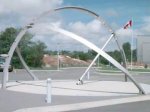 |
Sudbury |
Ontario |
Canada |
Armillary Sphere |
Dial 359 |
| A monumental half armillary dial in stainless steel. At one end of 'Polaris Boulevard' which includes Terra, a segment of the globe oriented with Sudbury directly at the top. Celeste is a giant (12.8 meter or 42-foot) stainless steel sundial located at the south end of Polaris Boulevard. It consists of two arches, one which represents the equator in the sky, and one which represents the meridian. A large steel pipe makes up the gnomon of the sundial. |
| |
| |
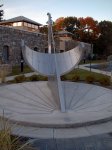 |
Suffern |
New York |
USA |
Compound Dial |
Dial 411 |
| Robert Adzema has designed a 10-foot tall, 12-foot long combination equatorial and horizontal dial made out of stainless steel. The equatorial dial has a wide arc showing hours from 6am to 6pm. At the noon hour is a 31-inch analemma illuminated by a 1/4-inch nodus in a rod gnomon. The pedestal holding the dial and rod is designed as the gnomon for an even larger horizontal ground level dial that surrounds the equatorial dial. For this horizontal dial, the hour lines are made of half-inch stainless steel bars are embedded in concrete. An inscription tells how to tell the time. |
| |
| |
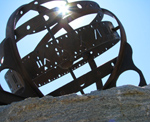 |
Summerland |
British Columbia |
Canada |
Armillary Sphere |
Dial 952 |
| A steel patinaed armillary sphere about 1.5m in diameter, mounted on a low boulder. The dial is marked by roman numerals etched completely through the thick equatorial band. Large holes form the hour moment, with smaller holes for the half and quarter hours. The meridian ring also serves as support for the dial. In addition are arctic and antarctic rings. A ball at the center of the dial has outlines of the continents, reflecting its status as a representation of the Earth at the center of the celestial sphere. The design of a slot mechanism allows the equatorial ring to be rotated by 15° for Daylight Saving Time. A simple Equation of Time plaque attached the boulder has explanatory notes allows correction to civil time. |
| |
| |
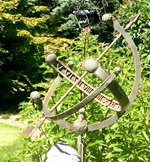 |
Summerland |
British Columbia |
Canada |
Equatorial Dial |
Dial 969 |
| This is a standard equatorial in reasonable condition, mass produced, probably steel, about 2 feet in diameter. As at 2019, it is loose on its base and so visitors are likely to find it out of alignment. It is mounted on a rough stone pedestal decorated with strips of metal reminiscent of plant foliage reaching up around it. |
| |
| |
 |
Sun City |
Arizona |
USA |
Horizontal Dial |
Dial 8 |
| A monumental horizontal dial in a gravel rock garden. Gnomon is 22 feet high, 40 feet long built from a structural steel "I" beam 64 feet long. Gnomon is supported by three concrete triangular legs and is encased in concrete with four shadow-casting style edges. A circular concrete walkway under the gnomon has painted Roman numeral hour markers. |
| |
| |
 |
Sunderland |
Maryland |
USA |
Horizontal Dial |
Dial 259 |
| A brass horizontal dial 11.5 inches in diameter with a 7 inch high gnomon. The dial is intricately engraved and includes compass points and gradations of the clock to two minutes. Made by "E. Nairne", a London dial maker in the 1750's to 1800. Rector Stephanie Chase Wilson says "I believe it was made specifically for our church as it has the name "All St.s Parish Calvt County" written on the face on the opposite side from "E. Nairne." The oral history of its origins is that it was commissioned by the Rev. Thomas Claggett, rector of All Saints from 1769-1777, and again from 1786-1792. He gave the sundial to the church in thanksgiving for being called as the first Bishop consecrated on American soil on September 17, 1792 in Trinity Church, New York."
"About 15-20 years ago the sundial was stolen from the church, but a quick-thinking parishioner got word out to every antique store within 100 miles and several days later it was recovered. A replica was created and now sits outside the church on a pedestal. The original is under lock and key. The only special care it gets is an occasional dusting. " |
| |
| |
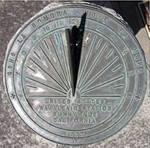 |
Sunnyvale |
California |
USA |
Horizontal Dial |
Dial 1081 |
| Farenholt sundial for U.S. Naval Air Station Sunnyvale CA. This cast bronze dial was designed and commissioned by RADM Farenholt for U.S. Naval Hospitals at bases where he was commanding officer, visited, or had special meaning to him. The dial is 18 inches (46cm) in diameter. The outer chapter ring has the motto, followed by a chapter ring with Arabic hours 6am to 6pm, raised hour lines that radiate from near the foot of the gnomon and short half-hour lines. The gnomon has graceful curves and a star cut-out in the center. Below the gnomon is the naval command name, followed by the commissioning date in the southern portion of the hours chapter ring. |
| |
| |
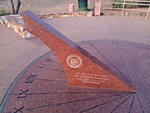 |
Sunset Point Rest Area |
Arizona |
USA |
Horizontal Dial |
Dial 1050 |
| Sitting on a low dais is a beautiful red granite sundial. The gnomon is about 1.5m high and 20cm wide sitting in the center of a dial about 2.5m in diameter. Hour lines radiate from the gnomon foot to the edge of the dais, marking the hours from VI (AM) to VI (PM) local solar time. Inscriptions are on both the east and west side of the gnomon, a plaque and names of those who died serving the citizens of the State of Arizona. |
| |
| |
|
Superior |
Arizona |
USA |
Horizontal Dial |
Dial 105 |
| A small 8 in. bronze horizontal dial with raised Arabic numerals marking the hours. The dial is set on a massive cobble stone and mortar base suitable for sitting upon while watching the hours. |
| |
| |
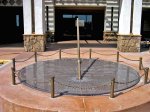 |
Surprise |
Arizona |
USA |
Horizontal Dial |
Dial 574 |
| A 108-inch diameter granite dial face with a 92-inch steel gnomon and nodus. Dial furniture includes a solar noon mark, sunrise and sunset points on the solstices and equinoxes, ecliptic date lines and an EOT graph. |
| |
| |
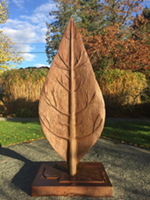 |
Surrey |
British Columbia |
Canada |
Sculpture/Artwork |
Dial 934 |
| The sculpture, titled "Gnomon", is a metal clematis leaf about 9ft tall and 3ft 6in wide at its widest point. It varies from about 1 in at the edge to about 4 in in the middle. The base is marked with cardinal directions and a present map of the neighborhood. There are a series of twelve 9 inch disks arranged around the sculpture set at a radius of 9 ft. The disks are positioned every 30 degrees around the circle, and at the north point, is an additional disk for "12 PST". All components of the sculpture are case iron, set into a graveled area. According to accompanying information,"Gnomon, featured in Fleetwood Park’s perennial garden, is inspired by the notion of a sundial marking time. A gnomon is the central part of a sundial that casts a shadow that marks the passage of time. This artwork tells the story of the passage of time in the growth, change, and appearance of Fleetwood’s historic community landmarks. |
| |
| |
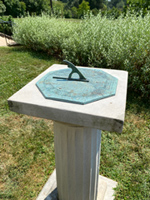 |
Swarthmore |
Pennsylvania |
USA |
Horizontal Dial |
Dial 1018 |
| This octagonal dial was given to Swarthmore in memory of their classmate Howard White Jr. The dial was originally placed in the Scott Arboretum on Parish Lawn but was removed for pathway reconfiguration in 2006. An alum Bob Thompson found that the dial was stored under the bleachers alongside Skallerup Track. n honor of Thompson’s 92nd birthday, the Arboretum returned the sundial placing in in front of Pearson Hall for the next generation of students to enjoy. |
| |
| |
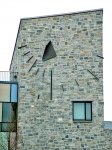 |
Swarthmore |
Pennsylvania |
USA |
Vertical Dial |
Dial 35 |
| Modern design for a vertical dial declining 20.5 deg east on a stone block wall. The gnomon is a right-angled sheet of bronze, casting shadows onto granite hour marks from 6am to 4pm. The dial was designed by Marti Cowan using Waugh's formulae for vertical dials. Frederick Orthlieb, professor and chair of the Dept of Engineering at Swarthmore "had a part in locating the bent-plate gnomon so as to give correct indications on the vertical wall. As installed, the gnomon's indicating edge (which lies on a Polar Axis) casts quite a short shadow in Autumn and Winter and requires some observing skill to make a close estimate of indicated time, but in Spring and Summer the longer shadow moves over the granite hour marks very plainly." A double-line mark at 11am indicates noon during Daylight Saving Time. The second mark is slightly askew if one looks carefully. |
| |
| |
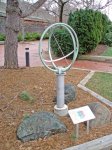 |
Sydney |
Nova Scotia |
Canada |
Armillary Sphere |
Dial 638 |
| An armillary sphere constructed from a large, dual-loop aluminum radio direction finding antenna. Outer ring is 80 cm (31.5 inch) diameter mounted on a 1.3 m (51 inch) pipe pedestal. Hour ring is stainless steel and marked in ten minute intervals showing local apparent time. A nearby plaque provides Equation of Time conversion to standard time. A second small style projects a shadow at noon local apparent time on a second vertical scale to show the sun's declination. |
| |
| |
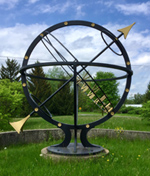 |
Syracuse |
New York |
USA |
Armillary Sphere |
Dial 382 |
| A 10 foot 2 inch diameter armillary sundial made of black anodized steel. The equatorial band is created by two narrow bands holding in open space 10-inch gold colored Roman numerals to grace each hour from 6am to 6pm. The gnomon is a traditional rod with gold arrow and tail flute. The armillary has arctic and antarctic circles, and a prime vertical that extends only to the horizon circle. The prime meridian has 12 gold flowers spaced every 30 degrees. The dial weighs about 8000 lbs and sits on a small concrete base. |
| |
| |
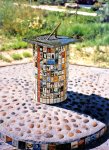 |
Taos |
New Mexico |
USA |
Horizontal Dial |
Dial 493 |
| A copper and bronze horizontal dial about 15 x 15 inches. The dial was built by the Rocky Mountain Youth Corp, an organization the helps direct the energies of "at risk" youth. Base of dial is clad with 2x4 inch glazed tiles made by all the 5th graders in town. There is a compass rose around the base and on dedication day, an area of wet cement was available those present to make an inscription or hand print. |
| |
| |
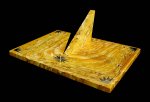 |
Tempe |
Arizona |
USA |
Horizontal Dial |
Dial 23 |
| A horizontal dial from Picture Rock Sandstone with 24k gold-plated inlaid brass fittings, 25 inches wide by 36 inches long, with gnomon 12.5 inches high. Gnomon is 1.5 inches thick. Total sundial weight 110 lbs. |
| |
| |
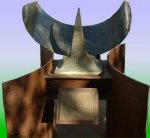 |
Tempe |
Arizona |
USA |
Equatorial Dial |
Dial 75 |
| An equatorial dial designed by R. Newton Mayall with a "curved triangular gnomon over a curved face approximately 12-in (.3m). wide. Tells the day of the year and standard time noon." Has a plaque explaining the Equation of Time. |
| |
| |
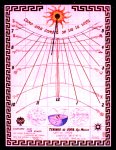 |
Tenango de Doria |
Hidalgo |
Mexico |
Vertical Dial |
Dial 459 |
| A very striking vertical reclining dial 85 x 115 cm created from hand painted tiles, each individually fired in a kiln and assembled at Tenango de Doria by David Canyedo. In addition to hour lines, the dial includes declination lines for the solstices and equinox. The dial includes constellation maps of both the northern and southern hemispheres, a celestial sphere, and rose of winds (compass). The artistry also includes NAHUI OLLIN (the fifth sun which is the era we are living in according to the Aztecs). The dial has an equation of time that allows conversion from local solar time to standard time. The dial was designed to arouse interest of high school students in astronomy. |
| |
| |
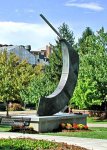 |
Terre Haute |
Indiana |
USA |
Sun Alignment |
Dial 586 |
| Via Solaris, a 20x15x4 foot granite, stainless steel and bronze calendrical dial showing yearly equinoxes and summer solstice. |
| |
| |
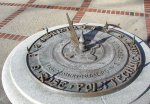 |
Terre Haute |
Indiana |
USA |
Horizontal Dial |
Dial 685 |
| A round bronze horizontal dial with 6 AM to 6 PM hour lines and half-hour lines and Arabic hour numerals. Eight perimeter points and the one central decorative point may represent alignments but no explanation is given. Dial sits on a carved stone column. Base marked 1920 1921 1922 1923. |
| |
| |
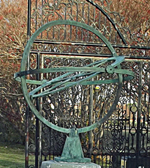 |
Terrel |
Texas |
USA |
Armillary Sphere |
Dial 1049 |
| When is a sundial not a sundial? At first glance it appears to be an armillary sphere, but upon closer inspection, it is missing both a gnomon rod and an equatorial ring to mark the hours. Then, in another view of the dial we see that the angled ring with spokes actually contains hour numbers and could be the missing equatorial ring. Further, it a rod had been attached perpendicular to the ring, and the ring were tilted to the co-latitude, we'd have a working armillary sundial. The missing gnomon rod may have fastened to the meridian ring. Bottom line: with some care, this sundial can be saved and become a working sundial again. |
| |
| |
 |
Thunder Bay |
Ontario |
Canada |
Analemmatic Dial |
Dial 466 |
| A very well constructed analemmatic dial about 24 by 11 feet. The dial may be difficult to find, since it is in the center of a field that is devoted to wild grass of the area. Cement markers are used to show the hours and for the central base showing the months where to stand. The hourly markers are corrected for the longitude of Thunder Bay. The site is visited quite frequently by school children and is a great educational tool for dialing. |
| |
| |
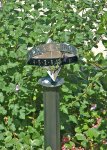 |
Toledo |
Ohio |
USA |
Equatorial Dial |
Dial 621 |
| An equatorial projection dial 18 inches wide atop a 3 foot high fluted steel column. Located on the Anthony Wayne Trail Bridge inside the zoo near its entrance, access requires zoo admission. Dial sits atop a three foot high fluted steel column. |
| |
| |
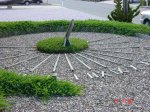 |
Toms River |
New Jersey |
USA |
Horizontal Dial |
Dial 507 |
| A horizontal dial about 22 feet in diameter. The dial base is stone and gravel outlined in shore juniper plants. Treated lumber, now gray through weathering, is used for the both the hour lines and the marking Roman numeral hours. Nicely fashioned with a hub of green junipers in the center surrounding a simple wood gnomon. Builder Richard Perez started off just wanting something a little different?and the sundial emerged in 1992 as the main theme of landscaping. |
| |
| |
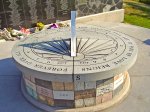 |
Toronto |
Ontario |
Canada |
Horizontal Dial |
Dial 596 |
| A 210 cm diameter horizontal dial of blue granite with a 56 cm high stainless steel gnomon. In addition to showing local time, the declination line that touches the base of the gnomon traces the path of the shadow on June 23 (date of the 1985 Air India terrorist-bomb air crash) and also marks solar noon at the crash site near Akahista, Ireland where there is a similar memorial sundial. Stones forming the pedestal represent all of the Provinces and territories of Canada, and the countries of India, Ireland, Japan and the United States of America. |
| |
| |
|
Toronto |
Ontario |
Canada |
Horizontal Dial |
Dial 128 |
| Approx 55 ft square Stone (concrete?) 4AM-8PM marked in Arabic numerals, half and quarter hours marked with lines. A huge dial. The gnomon is sunk below the outer level by a series of steps. The hours are marked by stone slab 'seats' spaced around the outer square. There are two seats at the noon position to allow for the width of the gnomon. This dial no longer exists. |
| |
| |
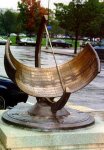 |
Toronto |
Ontario |
Canada |
Equatorial Dial |
Dial 364 |
| The face of this equatorial dial is an arc of a sphere 2 meters in diameter. A nodus on the polar gnomon casts a shadow indicating solar declination. Aligned with the dial is a 15 meter meridian line which passes through the site of the transit instrument of the former Toronto Observatory. |
| |
| |
 |
Toronto |
Ontario |
Canada |
Armillary Sphere |
Dial 413 |
| Armillary dial about 4 foot in diameter. Gnomon rod appears to be missing. Raised Roman numbers show the hours from V in the morning to VII at night. Equatorial strip is about 6 inches wide. |
| |
| |
 |
Toronto |
Ontario |
Canada |
Equatorial Dial |
Dial 414 |
| An equatorial dial with rod gnomon bent into a half analemma. Raised Roman numerals along the equatorial arc from V in morning to VII at night. The gnomon is held by semi-circular arc with pleasing proportions that match the equatorial arc. |
| |
| |
 |
Toronto |
Ontario |
Canada |
Horizontal Dial |
Dial 433 |
| A striking 30 inch diameter horizontal dial. The equation of time correction is made by a slight rocking of the gnomon about the polar axis, controlled by a manual date index and a hidden cam mechanism. At the south end of the gnomon on the dial is a sunburst design. The octagonal pedestal is ornately covered with six copper plates. Each showing two zodiac signs in relief, forming a frieze 20 inches high around the pedestal. |
| |
| |
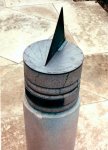 |
Toronto |
Ontario |
Canada |
Horizontal Dial |
Dial 435 |
| A small bronze 8 inch diameter horizontal dial, sitting upon a granite column of equal diameter. The dial plate has simple radiating hour lines and Roman numerals. No minute or quarter hour marks. The gnomon may have broken off at some time and been repaired, since it is now held on by a rather unsightly bronze angle iron. |
| |
| |
 |
Torre |
Coahuila |
Mexico |
Analemmatic Dial |
Dial 509 |
| An analemmatic dial with major axis of 18 feet built of many different types of stone from the Torre?n Jard?n area, including white and red marble, travertine, yellow and black flagstone, and limestone. Insets of gray stone hold the hour markers from 5am to 7pm. The finished dial has been set in desert plants, native to the region, including: Candelilla, Gobernadora, Lechuguilla, Sangre de drago, Huevo de toro, Biznaga, Pitaya, Corona de espinas, Nopal rastrero, and Cardenche. These are all protected desert species. The dial has a compass rose and six disk-shaped maps at the east and west sides to show the course of sunrise/sunset across the Mexican Republic on the solstices and equinox. |
| |
| |
|
Torreon |
Coahuila |
Mexico |
Vertical Dial |
Dial 487 |
| This is a stone cube 3.5 m high with four vertical dials. Each dial face is about 2.2 m high by 1.25 m wide The South and North faces have Arabic numerals to indicate solar time from 6am to 18hrs, with marks every 15 minutes. The East face has numerals from 6am to 12pm and the West face complements from 12pm to 18hrs. These faces have half hour marks. The South face has seven declination lines, constellation dates, analemma line, zodiac symbols, and equinoctial and solstice lines. A curve to indicate light and shadow hours all the year is on each face. A square base on quarry. At the north-east corner are the carved names of the designer Miguel Bertran de Quintana and builder Cirilo Nunez.
Note: because of the sundial size and latitude, it was necessary to extend the four vertical faces of the sundial into the horizontal plane to indicate the summer solstice line and 11:30 and noon hours of summer. |
| |
| |
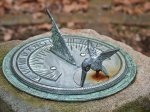 |
Towson |
Maryland |
USA |
Horizontal Dial |
Dial 334 |
| A bronze horizontal dial made inscribed "1715". About 10 inches in diameter with an ornately decorated dial plate.
The original gnomon has been removed and a modern garden sundial placed over the original dial face; little of the original face is visible. The dial is on a square stone that sits atop a plane square cut stone pillar. |
| |
| |
 |
Traverse City |
Michigan |
USA |
Analemmatic Dial |
Dial 494 |
| This beautiful analemmatic dial was built as part of the American Society of Landscape Architects' 100 years/100 Parks project. A colored concrete pad was poured on the north/south axis and scored joints for each month. Stainless steel plates show the name of the months. On either side of the concrete pad are dry laid flagstones with creeping thyme in the joints. Hour markers are 12 inch diameter colored concrete bases with numbers cut from stainless steel. A stained glass sun plaque at the top of the month axis was made by a local artisan. Total dial size is about 10 x 20 feet. |
| |
| |
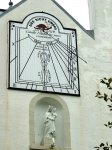 |
Trois Rivieres |
Quebec |
Canada |
Vertical Dial |
Dial 66 |
| A declining vertical dial approximately 6 feet wide and 8 feet tall of painted wood. Diol declines 58? west of south. Dial includes a two-lined analemma noon mark that shows noon corrected for EOT. Hour lines with Roman numerals show local time from 10 AM to 7 PM. Dial is located about 30 feet high on a wall, above an alcove with a statue of the Virgin Mary. The gnomon length is correct for the shadow of the tip to fall on the noon mark. Dial furniture includes a lunar crescent and a depiction of a beaver carrying a tree branch, in a classic French tradition and similar to dials of Zarbula's overall design. |
| |
| |
 |
Tucson |
Arizona |
USA |
Equatorial Dial |
Dial 4 |
| A bronze equatorial dial approximately 2 ft. in diameter designed by R. Newton Mayall. Mayall stated, "When I was asked to design the sundial in front of the Museum at Kitt Peak I was more than pleased, for it gave me a chance to work a semblance of astronomy into it. The design reflects the great telescope nearby, with its base and fork type mounting, the dial itself being the "telescope"." |
| |
| |
 |
Tucson |
Arizona |
USA |
Sun Alignment |
Dial 11 |
| A "Stonehenge" or sun circle dial designed by Chris Tanz, Susan Holman, Paul Edwards and with the help of Will Grundy and sponsored by the Pima County Flood Control and Transportation Dept. The structure uses a broken circle of walls to create designs made of light based on the movement of the sun. The circle, 50 feet in diameter with 8 foot walls is modeled loosely on the Casa Rinconada kiva ruins in Chaco Canyon, N.M. The walls are of integrally colored concrete block, concrete, and flagstone. Lines on a bronze plaque indicate north and south and the direction of sunrise and sunset on the equinoxes and solstices. Holes in the wall do the same. Solar noon is marked when sunlight comes through a slot in the South wall and passes a line on the floor. |
| |
| |
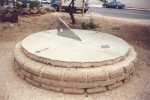 |
Tucson |
Arizona |
USA |
Horizontal Dial |
Dial 12 |
| This concrete and adobe brick horizontal dial is approximately 8 1/2 feet in diameter with a triangular gnomon 25 x 32 inches. This is a large, but very plain sundial except for the shiny chrome plated gnomon. It lacks numerals, but has hour points and shows the cardinal points. The dial is corrected for longitude. The pedestal is missing some bricks and is adorned with graffiti. |
| |
| |
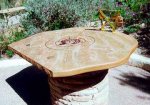 |
Tucson |
Arizona |
USA |
Horizontal Dial |
Dial 14 |
| A 25 inch circular engraved horizontal dial in a large irregular stone. Surrounding the dial on the stone are zodiacal signs and a beautiful engraved drawing of the surrounding mountains. The designer, John Carmichael, calls these dials "horizontal string heliochronometers" since the gnomon is a brass cable held very straight under tension from a heavy counterweight which is suspended from a brass hinged lever. |
| |
| |
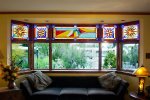 |
Tucson |
Arizona |
USA |
Vertical Dial |
Dial 533 |
| A declining vertical stained glass "Gecko" sundial 58 x 20 inches consisting of 153 colored glass pieces and exterior rod gnomon with triangular base. Paintings on 11 glass pieces use vitreous kiln-fired enamels and stains. Dial and four adjacent panels consisting of 540 glass pieces are set in bay window overlooking succulent garden containing additional sundials. Dial glass panel includes painting of a Tucson Banded Gecko stalking fly, a star field, sun face and solar noon mark. Dial declines 27.4? east of south. Contact owner John Carmichael to arrange viewing. |
| |
| |
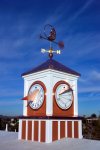 |
Tucson |
Arizona |
USA |
Vertical Dial |
Dial 544 |
| Four vertical dials on the faces of a 100-inch tall redwood cupola on the roof of a private residence. The 21-inch dial faces are kiln-fired porcelain on steel; the bezels and gnomons are copper. The dials are longitude corrected for MST. Three dials have solar noon marks. |
| |
| |
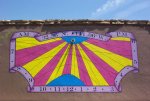 |
Tucson |
Arizona |
USA |
Vertical Dial |
Dial 566 |
| A vertical 44x92 inch dial declining 4.53? east of south painted on the rough textured stucco wall of a private home. The 2x4 inch tall conical horizontal gnomon is gold plated brass. The dial face is hand painted with elastomeric acrylic exterior house paint. The horizontal conical gnomon optimizes the nodus shadow at the location low latitude to show time and date. Dial face shows date/declination lines, solar noon mark and hour, 1/2-hour and 15 minute lines. To arrange viewing, contact owner Christina McVie. |
| |
| |
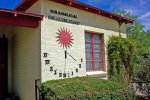 |
Tucson |
Arizona |
USA |
Vertical Dial |
Dial 579 |
| Located on a side street wall of a private home, this 4x6 foot due south vertical dial uses welded iron numerals and gnomon. Built in 1954, this is the oldest known sundial in Tucson. Designed using Mayall and Mayall's "Sundials" and described in detail in April, 1954 Home and Garden Magazine. |
| |
| |
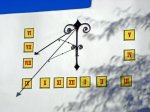 |
Tucson |
Arizona |
USA |
Vertical Dial |
Dial 711 |
| An 84x47 inch vertical dial declining 18? east of south on the outside wall of a private residence. Roman hour numerals are on 8 inch square hand-painted ceramic tiles. The gnomon and support are welded wrought iron painted black. A hand painted EOT graph is shown on a matching ceramic tile.
This is a historic home designed by southwestern architect Josias Joesler. Homeowner found original architectural drawings showing a gnomonically-flawed sundial that was never installed and contacted John Carmichael to design this accurate new dial. |
| |
| |
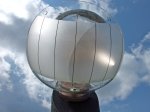 |
Tucson |
Arizona |
USA |
Globe or Hemispheric |
Dial 735 |
| A fused silica glass spherical lens projects a solar image spot onto the inner surface of a spherical segment of glass with a frosted area inscribed with hour lines and Arabic hour numerals. Time is read from the bright spot of light on the frosted surface while standing under the dial. Dial is mounted atop a pipe pillar on the patio of the Visitor Center. |
| |
| |
 |
Tucson |
Arizona |
USA |
Sun Alignment |
Dial 1039 |
| The Vista Sun Wheel is 63 feet [19.2 m] outside diameter and 197 feet [60 m] in circumference. The Wheel is composed of 28 tons of broken limestone. The central cairn is 11 feet [3.4 m] in diameter and 3 feet [1 m] high. In the center is a post marked by a sandstone block about 30 inches [76 cm] tall. The floor of the Sun Wheel called for another 28 ton of crushed decomposed red granite about 3/4 inch [2 cm] thick. Stone spokes indicate the solstices and equinox. Other stones 30-40 inches [75-100 cm] are set to various alignments outside the ring. A post indicates the setting sun on Groundhog Day, indicating one of the cross quarter days. The layout was made by direct observation, watching the progress of the sun along the horizon to solar standstill then return. 18 months were required to observe, mark and verify positions then setting stone and making the ring. The layout is similar to the Bighorn Wheel in Wyoming. |
| |
| |
 |
Tucson |
Arizona |
USA |
Analemmatic Dial |
Dial 825 |
| This nearly 14-foot wide analemmatic human sundial replaces the previous sundial at the same location. The previous dial by an unknown designer had several design errors and was in poor condition. The Flandrau Planetarium replace it, choosing a sundial with a blue background and white hour numerals. Dial Markings include quarter hour marks, Solar Noon Mark, Date Line with one week marks, Alignment Marker for Sunrise and Sunset (Bailey Points) with Solstice and Equinox lines, and the four Cardinal Points of the compass. The dial has a built-in longitude correction and shows Mountain Standard Time when readings are adjusted for The Equation of Time |
| |
| |
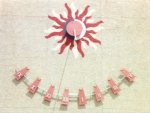 |
Tucson |
Arizona |
USA |
Vertical Dial |
Dial 456 |
| This is a 10 x 10 foot south vertical wall dial with hour lines painted on the wall that are corrected for longitude. A unique feature of this dial is the time scale can be rotated forward or back slightly to compensate for the Equation of Time. However, because only the hours are marked, precise minute reading is difficult. Welded steel was used to make the time marker ring and gnomon. |
| |